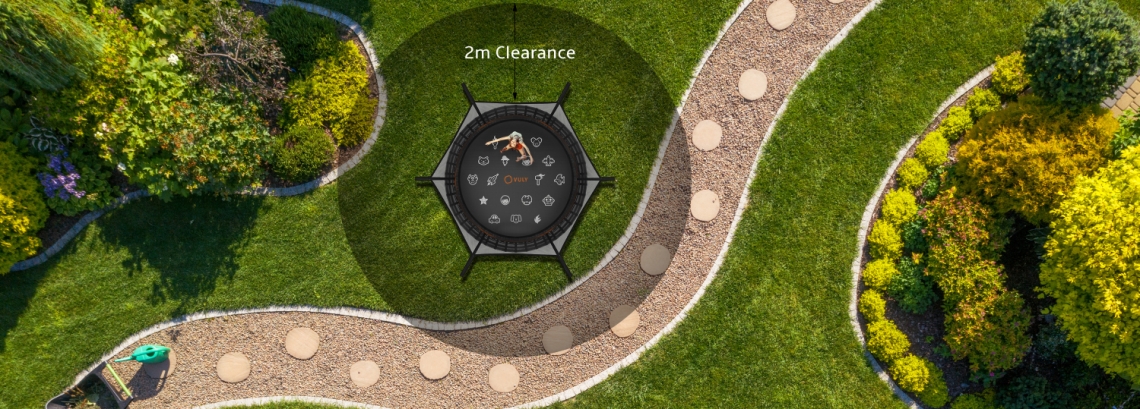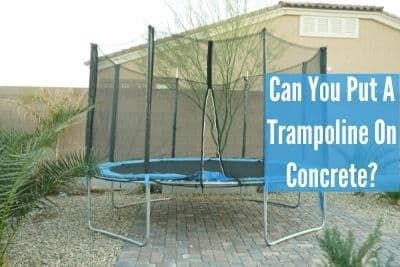Yes, you can put trampolines on concrete, but it’s not recommended without protective measures. Using a trampoline on concrete requires padding or a rubber base to prevent injuries and damage to the trampoline.
Trampolines provide a fantastic way for both children and adults to enjoy the outdoors and stay active. However, safety and equipment longevity are paramount when placing a trampoline on a hard surface, such as concrete. Unlike grass, concrete won’t absorb shock or provide any form of cushioning, which increases the risk of injury if a user falls off.
Moreover, direct contact with concrete can wear out the trampoline’s frame and springs much quicker than if it were set up on a softer surface. Therefore, to ensure a safe and enjoyable bouncing experience, investing in proper safety measures, like a trampoline safety pad or rubber mats, is essential when setting up your trampoline on a concrete surface.

Credit: www.youtube.com
Safety Concerns For Trampolines On Concrete
Putting a trampoline on concrete requires extra safety measures. Concrete is a hard surface. A soft landing is important on a trampoline. Safety is a top priority when it comes to fun activities. Kids and adults enjoy bouncing without thinking about dangers. Understanding these dangers helps prevent accidents. Safe bouncing means being informed and prepared.
Risk Of Injury Without Proper Impact Absorption
Jumping on a trampoline can be risky. Especially on concrete. Falls can lead to serious injuries. Concrete doesn’t absorb shock well. Unlike grass or specialized surfaces. Safe bouncing needs good shock absorption. This helps protect jumpers from harm. Protective measures are important for safe fun.
Ways to increase safety:- Use safety nets around the trampoline.
- Place impact-absorbing mats on the concrete.
- Regularly check equipment for wear and tear.
Potential Damage To The Trampoline Frame
Concrete can also damage the trampoline itself. It’s a hard surface. It can cause the frame to bend or break. A damaged frame increases the risk of accidents. Proper care can lengthen the life of your trampoline. Always protect the frame from hard impacts. This is important for everyone’s safety.
| Concern | Action |
|---|---|
| Frame bending | Check frame integrity often |
| Wear and tear | Replace parts as needed |
Making the right decisions about where to place your trampoline is key. Choose the ground that is safe and suitable for bouncing. Always prioritize safety.
Preparation For Installation
Before leaping into setting up your trampoline, proper preparation ensures safe and secure installation. The preparation phase for installing a trampoline on concrete involves a careful evaluation of the area and gathering the right tools. Let’s break down these critical first steps.
Assessing The Space And Concrete Surface Condition
A thorough assessment is crucial to guarantee your trampoline stands stable and ready for action. Identify the exact spot where your trampoline will go. Keep an eye out for any obstacles such as fences, trees, or overhead wires. The area should be level and free from debris. Inspect the concrete surface for cracks or unevenness that could affect stability.
- Space requirement: Ensure there’s ample room around the trampoline.
- Surface inspection: Look for smooth, flat concrete to prevent wobbling.
Necessary Tools And Materials For Setup
Installing a trampoline on concrete requires specific tools and materials. A list of what’s needed will pave the way for a hassle-free setup. Typical trampolines come with the necessary equipment, but double-check before you start. You’ll need a trampoline anchor kit designed for concrete surfaces.
| Tools | Materials |
|---|---|
| Rubber Mallet | Trampoline Anchor Kit |
| Measuring Tape | Shock-absorbing Mat |
| Wrench Set | Protective Frame Pads |
- Examine your toolkit: Confirm you have all the required tools.
- Secure proper materials: Trampoline on concrete needs extra safety materials.
Impact-minimizing Solutions
So, you have concrete space and a trampoline? No worries!
Impact-minimizing solutions come to the rescue. They protect the trampoline and keep jumpers safe.
Trampoline Mats And Pads As A Buffer
Concrete is hard. So, trampoline mats and pads are crucial. They absorb shocks. This means fewer injuries and a longer life for your trampoline.
- Shock-Absorption: Mats and pads reduce bounce impact.
- Durability: They protect against wear and tears.
- Safety: Add cushioning for falls and slips.
Benefits Of Using Rubber Feet Or A Trampoline Base
Another great way to protect your trampoline is by using rubber feet or a base.
| Feature | Benefit |
|---|---|
| Stability: | Prevents the trampoline from moving. |
| Floor Protection: | Stops the legs from scratching the concrete. |
| Shock Absorption: | Less stress on trampoline joints. |
Using these solutions extends the life of your trampoline.
It also means you can jump with peace of mind.
Maintenance And Longevity
Maintenance and longevity are crucial when it comes to keeping your trampoline in great shape. Especially when placed on concrete, you must give your trampoline a little extra love to ensure it lasts for years.
Regular Inspection For Wear And Tear
Jumping with joy also means jumping with care. Always look out for potential damage.
- Check the frame: Look for rust or cracks.
- Examine the mat: Search for tears or weak spots.
- Inspect the springs: Ensure they’re firmly attached and not stretched out.
- Protective pads: Confirm they fully cover springs and frame edges.
Cleaning Tips For Trampolines On Concrete
Clean trampolines mean safe, slick jumps every time. Here’s how to keep it spotless.
- Clear debris: Sweep off leaves and dirt regularly.
- Wash the mat: Use mild soap and water, then rinse.
- Wipe the frame and springs: Prevent rust and buildup.
- Dry thoroughly: Avoid water collection that can cause damage.
Alternatives To Concrete Placement
Alternatives to Concrete Placement come into play when you prefer not to set your trampoline on concrete. Whether it’s about safety, aesthetics, or function, non-concrete solutions ensure a better environment for trampoline use. Let’s dive into options that keep your trampoline secure and your jumpers happy, away from the hard concrete.
Landscaping Ideas For Natural Ground Installation
Embracing natural ground for trampoline installation blends function with beauty. Here are top landscaping strategies:
- Level the Ground: Ensure a flat surface by leveling the ground.
- Add a Sand Bed: Sand acts as a cushion, absorbing some impacts.
- Use Garden Borders: Define the trampoline area with appealing borders.
- Install Bark Chips: Spread these around the trampoline for added protection.
- Plant Soft Shrubs: These provide a safety perimeter and enhance the look.
Portable Trampoline Options For Flexibility
Portable trampolines offer the ultimate in placement flexibility. Why they stand out:
| Feature | Benefit |
|---|---|
| Easy Assembly/Disassembly: | Moves with you, perfect for renters. |
| Lightweight Design: | Easy to reposition for best usage. |
| Use on Various Surfaces: | Safe on grass, dirt, or even indoor settings. |
Consider portable options for a safe and fun jumping experience wherever you go.

Credit: www.vulyplay.com

Credit: m.youtube.com
Frequently Asked Questions For Can You Put Trampolines On Concrete?
Is It Safe To Put A Trampoline On Concrete?
Placing a trampoline on concrete is not recommended. Concrete lacks shock absorption, increasing injury risk from falls. It’s hard, unyielding, and can cause significant harm.
What Should You Place Under A Trampoline On Concrete?
Use rubber mats or a specialized trampoline base when setting it on concrete. These materials provide cushioning, enhance safety, and preserve the trampoline’s structure from damage.
Can Trampolines Damage Concrete Surfaces?
Yes, trampolines can scuff or mark concrete over time. Movement from jumping may cause abrasion. Protective mats prevent such damage and should be considered for any installation.
How Do You Anchor A Trampoline On Concrete?
To anchor a trampoline on concrete, use weighted bags or trampoline anchoring kits designed for hard surfaces. Always ensure it is securely fastened to prevent movement and potential accidents.
Conclusion
Ultimately, placing trampolines on concrete requires extra precautions. Use rubber mats or crash pads for safety and longevity of the trampoline. Ensuring a secure setup avoids potential injuries and damage. For the best experience, prioritize proper installation and continual maintenance.
Enjoy bouncing safely on your well-protected trampoline!


